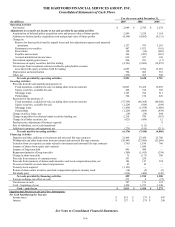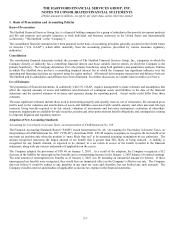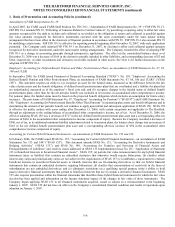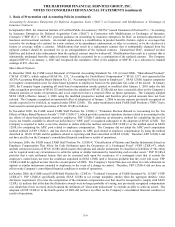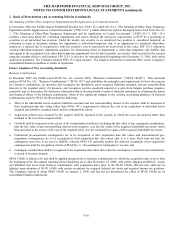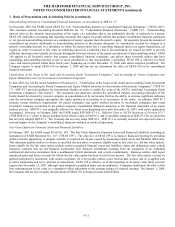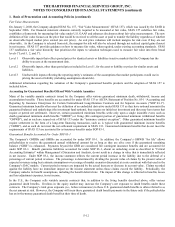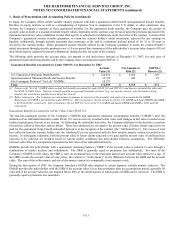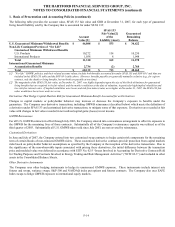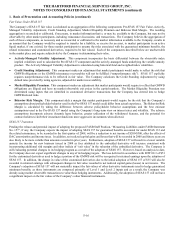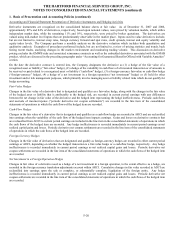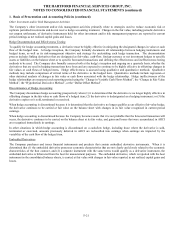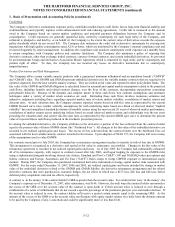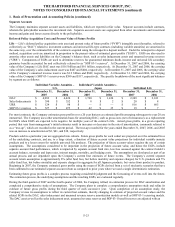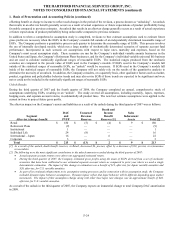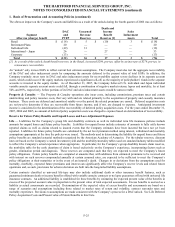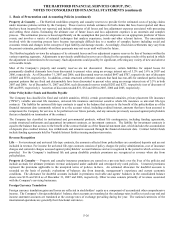The Hartford 2007 Annual Report Download - page 193
Download and view the complete annual report
Please find page 193 of the 2007 The Hartford annual report below. You can navigate through the pages in the report by either clicking on the pages listed below, or by using the keyword search tool below to find specific information within the annual report.THE HARTFORD FINANCIAL SERVICES GROUP, INC.
NOTES TO CONSOLIDATED FINANCIAL STATEMENTS (continued)
F-16
1. Basis of Presentation and Accounting Policies (continued)
Fair Value Under SFAS 157
The Company’ s SFAS 157 fair value is calculated as an aggregation of the following components: Pre-SFAS 157 Fair Value, Actively-
Managed Volatility Adjustment, Credit Standing Adjustment, Market Illiquidity Premium and Behavior Risk Margin. The resulting
aggregation is reconciled or calibrated, if necessary, to market information that is, or may be, available to the Company, but may not be
observable by other market participants, including reinsurance discussions and transactions. The Company believes the aggregation of
each of these components, as necessary and as reconciled or calibrated to the market information available to the Company, results in
an amount that the Company would be required to transfer for a liability, or receive for an asset, to market participants in an active
liquid market, if one existed, for those market participants to assume the risks associated with the guaranteed minimum benefits, the
related reinsurance and customized derivatives, required to be fair valued. Each of the components described below are unobservable
in the market place and require subjectivity by the Company in determining their value.
• Actively-Managed Volatility Adjustment. This component incorporates the basis differential between the observable index
implied volatilities used to calculate the Pre-SFAS 157 component and the actively-managed funds underlying the variable annuity
product. The Actively-Managed Volatility Adjustment is calculated using historical fund and weighted index volatilities.
• Credit Standing Adjustment. This component makes an adjustment that market participants would make to reflect the risk that
GMWB obligations or the GMWB reinsurance recoverables will not be fulfilled (“nonperformance risk”). SFAS 157 explicitly
requires nonperformance risk to be reflected in fair value. The Company calculates the Credit Standing Adjustment by using
default rates provided by rating agencies, adjusted for market recoverability.
• Market Illiquidity Premium. This component makes an adjustment that market participants would require to reflect that GMWB
obligations are illiquid and have no market observable exit prices in the capital markets. The Market Illiquidity Premium was
determined using inputs that are identified in customized derivative transactions that the Company has entered into to hedge
GMWB related risks.
• Behavior Risk Margin. This component adds a margin that market participants would require for the risk that the Company’ s
assumptions about policyholder behavior used in the Pre-SFAS 157 model could differ from actual experience. The Behavior Risk
Margin is calculated by taking the difference between adverse policyholder behavior assumptions and the best estimate
assumptions used in the Pre-SFAS 157 model using the Company’ s long-term view on interest rates and volatility. The adverse
assumptions incorporate adverse dynamic lapse behavior, greater utilization of the withdrawal features, and the potential for
contract holders to shift their investment funds into more aggressive investments when allowed.
SFAS 157 Transition
Pending the release and potential impact of adopting the proposed FASB Staff Position, “Measuring Liabilities under FASB Statement
No. 157”, if any, the Company expects the impact of adopting SFAS 157 for guaranteed benefits accounted for under SFAS 133 and
the related reinsurance, to be recorded in the first quarter of 2008, will be a reduction to net income of $200-$300, after the effects of
DAC amortization and income taxes. In addition, net realized capital gains and losses that will be recorded in 2008 and future years are
also likely to be more volatile than amounts recorded in prior years. Furthermore, adoption of SFAS 157 will result in a lower variable
annuity fee income for new business issued in 2008 as fees attributed to the embedded derivative will increase consistent with
incorporating additional risk margins and other indicia of “exit value” in the valuation of the embedded derivative. The Company is
still evaluating potential changes to its hedging program as a result of the adoption of SFAS 157. However, based on analysis to date,
the Company does not expect significant changes in any of its hedging targets. The loss deferred in accordance with EITF 02-3 of $51
for the customized derivatives used to hedge a portion of the GMWB risk will be recognized in retained earnings upon the adoption of
SFAS 157. In addition, the change in value of the customized derivatives due to the initial adoption of SFAS 157 of $35 will also be
recorded in retained earnings with subsequent changes in fair value recorded in net realized capital gains (losses) in net income. The
Company’ s adoption of SFAS 157 will not materially impact the fair values of other derivative instruments used to hedge guaranteed
minimum benefits, as those instruments are composed primarily of Level 1 and Level 2 inputs and as a result, the Company was
already using market observable transactions to value those hedging instruments. Additionally, the adoption of SFAS 157 will not have
a significant impact on the fair values of the Company’ s other financial instruments.


